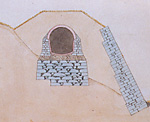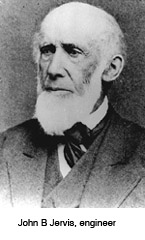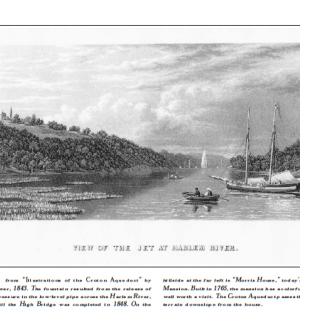An Urgent Need for Water
The Aqueduct was built in response to the fires and epidemics that repeatedly devastated New York City, owing in part to its inadequate water supply and contaminated wells. Major David B. Douglass, the project's first chief engineer, planned the route and structures and established the project's hydraulic principles. He was succeeded in 1836 by John B. Jervis, who achieved the final design of the Aqueduct and its major structures and led the complex construction effort. Work began in 1837, carried out largely by Irish immigrant labor.
 For most of its length, the Aqueduct is a horseshoe-shaped brick tunnel 8.5 feet high by 7.5 feet wide, set on a stone foundation and protected with an earthen cover and stone facing at embankment walls. Designed on principles dating from Roman times, the gravity-fed tube, dropping gently 13 inches per mile, challenged its builders to maintain this steady gradient through a varied terrain.
For most of its length, the Aqueduct is a horseshoe-shaped brick tunnel 8.5 feet high by 7.5 feet wide, set on a stone foundation and protected with an earthen cover and stone facing at embankment walls. Designed on principles dating from Roman times, the gravity-fed tube, dropping gently 13 inches per mile, challenged its builders to maintain this steady gradient through a varied terrain.
 To do so the Aqueduct was cut into hillsides, set level on the ground, tunneled through rock, and carried over valleys and streams on massive stone and earth embankments and – at Sing Sing Kill, the Nepperhan (Saw Mill) River, and the Harlem River - across arched bridges. Typically it is partly buried, with a telltale mound encasing it. As one learns to read the "clues." an understanding of how the tunnel engages the landscape deepens the trail experience.
To do so the Aqueduct was cut into hillsides, set level on the ground, tunneled through rock, and carried over valleys and streams on massive stone and earth embankments and – at Sing Sing Kill, the Nepperhan (Saw Mill) River, and the Harlem River - across arched bridges. Typically it is partly buried, with a telltale mound encasing it. As one learns to read the "clues." an understanding of how the tunnel engages the landscape deepens the trail experience.
Croton water first entered the Aqueduct at 5 am on June 22, 1842 (followed by a dauntless crew in a small boat, the Croton Maid) and emerged at the Harlem River 22 hours later. The water eventually filled two above-ground reservoirs – on the present sites of the Great Lawn in Central Park and the New York Public Library on Fifth Avenue – to great civic rejoicing.

Until 1955 the Old Croton Aqueduct brought water to New York City. (The northernmost portion reopened in 1987 and continues to supply water to the town of Ossining.) Though the Aqueduct was built to meet the city's needs for 100 years, the supply was soon insufficient due to the spiraling population growth to which it contributed. The New Croton Aqueduct, triple the size and much deeper underground, lies a few miles to the east. Built under Chief Engineer B. S. Church, it began service in 1890 and remains in service today. It has no walking trail.
While the state park designation ends at the New York City line, the Aqueduct continues for four or five miles through the Bronx. There its green corridor, managed by New York Parks & Recreation, follows a southward route through Van Cortlandt Park, past the east edge of Jerome Park Reservoir and along Aqueduct and University avenues to the famed High Bridge, which carried water in iron pipes cross the Harlem River to Manhattan to serve a growing population.
A fuller history of the Aqueduct can be found a the Ossining Heritage Area and Keeper's House visitor centers and in "Water for Gotham: A History" by Gerard Koeppel, 2000, Princeton University Press. An archive of Aqueduct material, donated by William Lee Frost to Croton-on-Hudson's Historical Reference Room (Municipal Building), may also be consulted; call 914-271-4574.
For more info in Aqueduct History, check out these links:
John Bloomfield Jervis Papers at the Jervis Public Library
Croton Aqueduct History from the Southeast Museum
Croton Aqueduct History - NY Historical Society
Forgotten New York Street Scenes (Old Croton Aqueduct)
Library of Congress images of the Aqueduct (Note: type "Croton aqueduct" into the search field at top left.)



